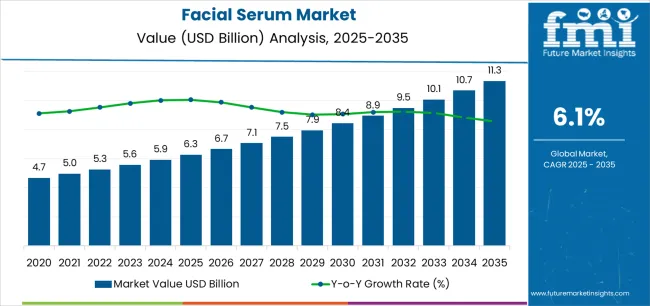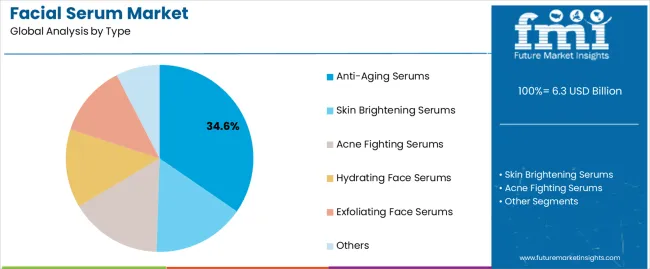The Facial Serum Market is estimated to be valued at USD 6.3 billion in 2025 and is projected to reach USD 11.3 billion by 2035, registering a compound annual growth rate (CAGR) of 6.1% over the forecast period.
The Facial Serum market is witnessing strong growth, driven by the rising consumer demand for specialized skincare products that address targeted concerns such as aging, hydration, and skin texture improvement. Increasing awareness about the benefits of concentrated active ingredients and the growing emphasis on preventive and personalized skincare are supporting market expansion. Technological advancements in formulation, including stabilized bioactive compounds and enhanced absorption mechanisms, are further strengthening product efficacy and consumer adoption.
The market is also benefiting from evolving lifestyle patterns, rising disposable incomes, and increased focus on self-care and beauty routines across diverse demographics. Distribution channels are expanding globally, enabling wider availability and convenience for end users.
Additionally, growing interest in clean, water-based, and natural formulations is influencing product development and marketing strategies As the skincare industry continues to innovate and respond to consumer preferences, the Facial Serum market is expected to experience sustained growth, supported by continuous product development, e-commerce expansion, and increased consumer education regarding efficacy and safety.

| Metric | Value |
|---|---|
| Facial Serum Market Estimated Value in (2025 E) | USD 6.3 billion |
| Facial Serum Market Forecast Value in (2035 F) | USD 11.3 billion |
| Forecast CAGR (2025 to 2035) | 6.1% |
The market is segmented by Type, Form, Distribution Channel, and Price Point and region. By Type, the market is divided into Anti-Aging Serums, Skin Brightening Serums, Acne Fighting Serums, Hydrating Face Serums, Exfoliating Face Serums, and Others. In terms of Form, the market is classified into Water Based, Oil Based, Gel Based, and Others. Based on Distribution Channel, the market is segmented into Online Retailers, Supermarkets & Hypermarkets, Drugstores & Pharmacies, Specialty Beauty Stores, and Others. By Price Point, the market is divided into Premium, Mass-Market, and Luxury. Regionally, the market is classified into North America, Latin America, Western Europe, Eastern Europe, Balkan & Baltic Countries, Russia & Belarus, Central Asia, East Asia, South Asia & Pacific, and the Middle East & Africa.

The anti-aging serums segment is projected to hold 34.6% of the Facial Serum market revenue in 2025, establishing it as the leading type. Its dominance is driven by the increasing demand for products that reduce visible signs of aging, improve skin elasticity, and prevent premature skin damage. Consumers are actively seeking serums enriched with concentrated active ingredients such as peptides, antioxidants, and hyaluronic acid, which provide measurable results.
Product efficacy, supported by scientific research and dermatological validation, has reinforced trust and preference among consumers. Rising awareness of preventive skincare and the growing aging population have further propelled adoption. The segment also benefits from marketing campaigns emphasizing anti-aging benefits and personalized skincare routines.
Continuous innovation in formulation technologies, including lightweight textures and enhanced skin penetration, ensures high consumer satisfaction As the demand for effective, targeted, and convenient skincare solutions rises globally, the anti-aging serums segment is expected to maintain its leadership, supported by strong product performance and evolving consumer preferences.

The water-based formulation segment is anticipated to account for 42.1% of the market revenue in 2025, making it the leading form. Growth is driven by the increasing preference for lightweight, non-greasy, and easily absorbable products that suit diverse skin types and climates. Water-based serums are perceived as gentle, compatible with other skincare routines, and effective in delivering active ingredients efficiently.
Rising consumer interest in clean, natural, and eco-friendly formulations further reinforces adoption. Manufacturers are continuously developing water-based serums with improved stability, enhanced absorption, and multifunctional benefits such as hydration, antioxidant protection, and brightening.
The segment also benefits from widespread availability across multiple sales channels, including retail stores, specialty skincare outlets, and e-commerce platforms As skincare routines become more personalized and consumer education regarding formulation benefits increases, the water-based form segment is expected to maintain its leading position, supported by both functional efficacy and evolving consumer preferences toward lightweight and versatile skincare solutions.

The online retailers segment is projected to hold 39.4% of the market revenue in 2025, establishing it as the leading distribution channel. Growth in this segment is driven by the increasing adoption of e-commerce platforms, which provide convenience, broader product availability, and competitive pricing. Consumers benefit from easy access to a wide variety of facial serum products, including niche and international brands that may not be widely available offline.
Digital platforms also enable targeted marketing, personalized recommendations, and customer reviews, which enhance trust and facilitate informed purchasing decisions. The expansion of online payment options, efficient logistics, and doorstep delivery services further support adoption.
Rising mobile internet penetration and the growing popularity of social media-driven skincare trends are contributing to the rapid growth of online retail As consumers increasingly prefer digital shopping experiences for convenience, variety, and engagement, the online retailers segment is expected to remain the primary driver of market growth, supported by continuous investment in digital platforms, user experience optimization, and targeted marketing strategies.
Thus, these key facial serum industry trends govern customer interest in various brands. Consequently, these trends influence facial serum market investment.
The historical period projected the market advancement at a promising CAGR of 8.1%, elevating the facial serum market size from USD 4.7 billion in 2020 to USD 6.3 billion in 2025.
Strict imposition of lockdown was the primary market driver in the pandemic era. Consumers started looking for different opportunities to experiment to pass the time. Skincare was a method that leveraged pastime activities and skin health maintenance. Hence, the demand for facial serums surged, driving the subject market.
Encapsulation enabled customers to smoothen their skincare routine. Also, the technological integration enabled the market to reduce the time consumed to apply serums and wait for them to become effective. Consequently, this was a key market driver for the industry.
| Historical CAGR from 2020 to 2025 | 8.1% |
|---|---|
| Forecast CAGR from 2025.7 to 2035.7 | 6.4.7% |
The forecasted period registers the rising consumer awareness about men’s skincare. Due to this, many key players started playing an active role in this segment. This created lucrative chances for investments in the facial serum brands working in a new market segment. Hence, this is a primary demand generator for the period.
The rising concern about sustainability will likely drive the subject market. Customers prefer organic and sustainable compounds, redefining the market's progress path.
North America is leading the global facial serum market. The main reason behind this is the growing consumer awareness regarding skincare treatments. Also, the market possesses great growth potential in the forecasted period.
Further, Europe contributes to the market along with the Asia-Pacific region due to the large-scale players investing in local facial serum brands.
Forecast CAGRs from 2025 to 2035
| Countries | Forecasted CAGR |
|---|---|
| The United States of America | 6.7% |
| The United Kingdom | 7.6% |
| China | 7.2% |
| Japan | 8.0% |
| South Korea | 7.9% |
| Category | Top Type- Anti-Aging Serums |
|---|---|
| CAGR % 2025 to End of Forecast (2035) | 6.2% |
| Market Segment Drivers | Growing concerns about skin health and wrinkles will likely govern the growth potential of the market segment. , The competitive landscape is flooded by numerous anti-aging serums, developing more choices for customers. , Therefore, this drives the market segment. |
| Category | Top Form- Water-Based |
|---|---|
| CAGR % 2025 to End of Forecast (2035) | 6.0% |
| Market Segment Drivers | The competitive landscape is estimated to grow the production of water-based serums due to their versatile properties. , Acne and wrinkle-reduction are the key benefits of the market segments, developing better growth opportunities for it. |

The competitive landscape of the facial serum market is governed by various key players, expanding with the help of numerous strategies. Their expansion's effectiveness determines these key players' growth potential. Key market expansion strategies include mergers and acquisitions, partnerships, strategic collaborations, and innovation.
For new entrants, the competitive landscape is highly cluttered. Product innovation is a key strategic move suggested to meet the demand-side and supply-side trends in the market.
Key Market Developments
| Attributes | Details |
|---|---|
| Estimated Market Size in 2025 | USD 6.3 billion |
| Projected Market Valuation in 2035 | USD 11.3 billion |
| Value-based CAGR 2025 to 2035 | 6.1% |
| Forecast Period | 2025 to 2035 |
| Historical Data Available for | 2020 to 2025 |
| Market Analysis | Value in USD billion |
| Key Regions Covered |
North America; Latin America; Western Europe; Eastern Europe; South Asia and Pacific; East Asia; The Middle East and Africa |
| Key Market Segments Covered | Type, Form, Distribution Channel, Price Point, Region |
| Key Countries Profiled | The United States, Canada, Brazil, Mexico, Germany, The United Kingdom, France, Spain, Italy, Poland, Russia, Czech Republic, Romania, India, Bangladesh, Australia, New Zealand, China, Japan, South Korea, GCC Countries, South Africa, Israel |
| Key Companies Profiled |
L'oréal S.A.; Galderma S.A; Amorepacific Group Inc.; KOSé Corporation; Clarins Inc.; Unilever plc; Shiseido Company Limited; Beiersdorf AG; Estée Lauder Companies Inc.; Revlon Inc. |
The global facial serum market is estimated to be valued at USD 6.3 billion in 2025.
The market size for the facial serum market is projected to reach USD 11.3 billion by 2035.
The facial serum market is expected to grow at a 6.1% CAGR between 2025 and 2035.
The key product types in facial serum market are anti-aging serums, skin brightening serums, acne fighting serums, hydrating face serums, exfoliating face serums and others.
In terms of form, water based segment to command 42.1% share in the facial serum market in 2025.






Full Research Suite comprises of:
Market outlook & trends analysis
Interviews & case studies
Strategic recommendations
Vendor profiles & capabilities analysis
5-year forecasts
8 regions and 60+ country-level data splits
Market segment data splits
12 months of continuous data updates
DELIVERED AS:
PDF EXCEL ONLINE
Facial Care Products Market Size and Share Forecast Outlook 2025 to 2035
Facial Recognition Market Size and Share Forecast Outlook 2025 to 2035
Facial Mask Maker Market Size and Share Forecast Outlook 2025 to 2035
Facial Erythema Treatment Market Size and Share Forecast Outlook 2025 to 2035
Facial Oil Market Analysis by Product Type, End User, Sales Channel and Region Through 2025 to 2035
Facial Tissue Paper Market Analysis - Trends, Growth & Forecast 2025 to 2035
Facial Steamer Market - Trends, Growth & Forecast 2025 to 2035
Facial Pumps Market Growth – Demand & Forecast 2025 to 2035
Facial Tracking Solution Market by Component, Technology Type, Industry & Region Forecast till 2035
Facial Tissue Market Growth – Size, Demand & Forecast 2024-2034
Facial Epilator Market Analysis – Size, Trends & Forecast 2024-2034
Facial Implants Market
Facial Recognition Machine Market
Bifacial Solar Module Market Size and Share Forecast Outlook 2025 to 2035
Craniofacial Implants Market Size and Share Forecast Outlook 2025 to 2035
Electric Facial Cleansing Brush Market Size and Share Forecast Outlook 2025 to 2035
Chelating Facial Masks Market Analysis - Size and Share Forecast Outlook 2025 to 2035
Gluten-Free Facial Product Market Trends – Growth & Forecast 2024-2034
Cranial And Facial Implants Market
Craniomaxillofacial Devices Market Size and Share Forecast Outlook 2025 to 2035

Thank you!
You will receive an email from our Business Development Manager. Please be sure to check your SPAM/JUNK folder too.
Chat With
MaRIA